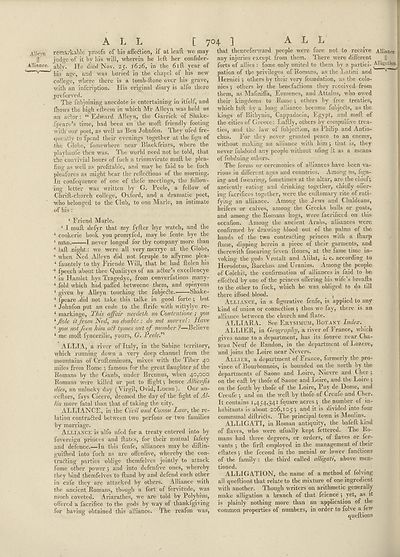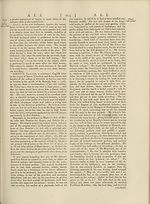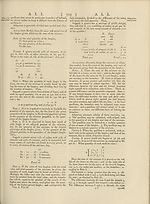Encyclopaedia Britannica, or, a Dictionary of arts, sciences, and miscellaneous literature : enlarged and improved. Illustrated with nearly six hundred engravings > Volume 1, A-AME
(750) Page 704
Download files
Complete book:
Individual page:
Thumbnail gallery: Grid view | List view

A L L [ 704. ] ALL
Alleyn remarkable proofs of bis affe&ion, if at leaft we may
H judge of it by bis will, wherein he left her confider-
Adlwmce. ably. pje died Nov. 25. 1626, in the 61ft year of
v bis age, and was buried in the chapel of his new
college, where there is a tomb-llone over bis grave,
with an infeription. His original diary is alfo there
preferved.
The fubjoining anecdote is entertaining in iti’elf, and
fhows the high etleem in which Mr Alleyn was held as
an actor: “ Edward Alleyn, the Garrick of Shake-
ipeare’s time, bad been on the moft friendly footing
with our poet, as well as Ben Johnfon. They uled fre¬
quently to fpend their evenings together at the fign of
the Globe, fomewhere near Blackfriars, where the
playhoufe then was. The world need not be told, that
the convivial hours of fuch a triumvirate mull be plea-
ling as well as profitable, and may be laid to be fuch
pleafures as might bear the reflections of the morning.
In conl’equence of one of thefe meetings, the follow¬
ing letter was written by G. Peele, a fellow of
Chrift-church college, Oxford, and a dramatic poet,
who belonged to the Club, to one Marie, an intimate
of his :
‘ Friend Marie.
‘ 1 mull defyr that my fyfler liyr watch, and the
4 cookerie hook you promyfed, may be fente bye the
‘ man. 1 never longed for thy company more than
‘ lafl night: we were all very merrye at the Globe,
‘ when Ned Alleyn did not fcruple to affyrme plea-
‘ fauntely to thy Friende Will, that he had ftolen his
‘ fpeech about thee Qualityes of an ador’s excellencye
‘ in Hamlet hys Tragedye, from converfations many-
‘ fold which had palled betweene them, and opinyons
4 given by Alleyn touching the fubjede. Shake-
4 fpeare -did not take this talke in good forte •, but
4 Johnfon put an ende to the llrife with wittylye re-
4 markinge, T/tts affair needeth no Contentione ; you
^ Jlole it from Ned, no doubts : do not marvel: Have
4 you not Jeen him atl tymes out of number ?■—Believe
4 me moll fyncerilie, yours, G. Pee/c.”
‘ ALLIA, a river of Italy, in the Sabi pc territory,
which running dowrn a very deep channel from the
mountains of Crufluminum, mixes with the Tiber 40
miles from Borne •, famous for the great daughter of the
Romans by the Gauls, under Brennus, when 40,000
Romans were killed or put to flight 5 hence Allievfu
dies, an unlucky day (Virgil, Ovid,Lucan). Our an-
ceflors, fays Cicero, deemed the day of the light of Al-
lia more fatal than that of taking the city.
ALLIANCE, in the Civil and Canon Law, the re¬
lation contraded between two perfons or two families
by marriage.
Alliance is alfo ufed for a treaty entered into by
fovereign princes and Hates, for their mutual fafety
and defence.—In this fenfe, alliances may be diflin-
guilhed into fuch as are offenfive, whereby the con-
trading parties oblige themfelves jointly to attack
fome other powerand into defenlive ones, whereby
they bind themfelves to Hand by and defend each other
in cafe they are attacked by others. Alliance with
the ancient Romans, though a fort of fervitude, was
much coveted. Ariarathes, we are told by Polybius,
offered a facrifice to the gods by way of thank!giving
for having obtained this alliance. The reafon was,
that thenceforward people were fure not to receive Alliance 1
any injuries except from them. There were different j|
forts of allies : fome only united to them by a partici- Alhgation
pation of the privileges of Romans, as the Latini and v |
Hernici; others by their very foundation, as the colo¬
nies 5 others by the benefadions they received from
them, as Mafmiffa, Eumenes, and Attains, who owed
their kingdoms to Rome ; others by free treaties,
which lafl by a long alliance became fubjeds, as the
kings of Bithynia, Cappadocia, Egypt, and moll of
the cities of Greece: Lallly, others by compulfive trea¬
ties, and the law of fubjedion, as Philip and Antio-
chus. For they never granted peace to an enemy,
without making an alliance with him } that is, they
never fnbdued any people without ufmg it as a means
of fubduing others.
The forms or ceremonies of alliances have been va¬
rious iu different ages and countries. Among us, fign-
ing and fwearing, fometimes at the altar, are the chief j
anciently eating and drinking together, chiefly offer¬
ing facriflces together, were the cuftomary rite of rati-
lying an alliance. Among the Jews and Chaldeans,
heifers or calves, among the Greeks bulls or goats,
and among the Romans hogs, were facrificed on this
occafxon. Among the ancient Arabs, alliances were
confirmed by drawing blood out of the palms of the
hands of the two contracting princes with a fharp
Hone, dipping herein a piece of their garments, and
therewith Uncaring leven Hones, at the fame time in¬
voking the gods Vrotalt and Alilat, i. e. according to
Herodotus, Bacchus and Uranius. Among the people
of Colchis, the confirmation of alliances is faid to he
effeded by one of the princes offering his wife's breaffs
to the other to fuck, which he was obliged to do till
there iffued blood. ,
Alliance, in a figurative fenfe, is applied to any
kind of union or connedion ; thus we fay, there is an
alliance between the church and Hate.
ALLIARA. See Erysimum, Botany Index.
ALLIER, in Geography, a river of France, which
gives name to a department, has its fource near Cha¬
teau Neuf de Randon, in the department of Lozere,
and joins the Loire near Nevers.
Allier, a department of France, formerly the pro¬
vince of Bourbonnois, is bounded on the north by the
departments of Saone and Loire, Nievre and i her
on the eaff by thole of Saone and Loire, and the Loire j
on the fouth by thofe of the Loire, Pay de Dome, and
Creuie j and on the weff by thofe of Creufe and Cher.
It contains 1,454,341 fquare acres ; the number of in¬
habitants is about 206,105 and it is divided into four
communal diffrids. The principal town is Moulins.
ALLIGATI, in Roman antiquity, the bafeff kind
of Haves, who were ufually kept fettered. rIhe Ro¬
mans had three degrees, or orders, of Haves or fer-
vants j the lirff employed in the management of their
effates 5 the fccond in the menial or lower fundions
of the family: the third called alligati, above men¬
tioned.
ALLIGATION, the name of a method of folying
all queHions that relate to the mixture of one ingredient
with another. Though writers on arithmetic generally
make alligation a branch of that fcience 3 yet, as it
is plainly nothing more than an application of the
common properties of numbers, in order to folve a few
queftions
Alleyn remarkable proofs of bis affe&ion, if at leaft we may
H judge of it by bis will, wherein he left her confider-
Adlwmce. ably. pje died Nov. 25. 1626, in the 61ft year of
v bis age, and was buried in the chapel of his new
college, where there is a tomb-llone over bis grave,
with an infeription. His original diary is alfo there
preferved.
The fubjoining anecdote is entertaining in iti’elf, and
fhows the high etleem in which Mr Alleyn was held as
an actor: “ Edward Alleyn, the Garrick of Shake-
ipeare’s time, bad been on the moft friendly footing
with our poet, as well as Ben Johnfon. They uled fre¬
quently to fpend their evenings together at the fign of
the Globe, fomewhere near Blackfriars, where the
playhoufe then was. The world need not be told, that
the convivial hours of fuch a triumvirate mull be plea-
ling as well as profitable, and may be laid to be fuch
pleafures as might bear the reflections of the morning.
In conl’equence of one of thefe meetings, the follow¬
ing letter was written by G. Peele, a fellow of
Chrift-church college, Oxford, and a dramatic poet,
who belonged to the Club, to one Marie, an intimate
of his :
‘ Friend Marie.
‘ 1 mull defyr that my fyfler liyr watch, and the
4 cookerie hook you promyfed, may be fente bye the
‘ man. 1 never longed for thy company more than
‘ lafl night: we were all very merrye at the Globe,
‘ when Ned Alleyn did not fcruple to affyrme plea-
‘ fauntely to thy Friende Will, that he had ftolen his
‘ fpeech about thee Qualityes of an ador’s excellencye
‘ in Hamlet hys Tragedye, from converfations many-
‘ fold which had palled betweene them, and opinyons
4 given by Alleyn touching the fubjede. Shake-
4 fpeare -did not take this talke in good forte •, but
4 Johnfon put an ende to the llrife with wittylye re-
4 markinge, T/tts affair needeth no Contentione ; you
^ Jlole it from Ned, no doubts : do not marvel: Have
4 you not Jeen him atl tymes out of number ?■—Believe
4 me moll fyncerilie, yours, G. Pee/c.”
‘ ALLIA, a river of Italy, in the Sabi pc territory,
which running dowrn a very deep channel from the
mountains of Crufluminum, mixes with the Tiber 40
miles from Borne •, famous for the great daughter of the
Romans by the Gauls, under Brennus, when 40,000
Romans were killed or put to flight 5 hence Allievfu
dies, an unlucky day (Virgil, Ovid,Lucan). Our an-
ceflors, fays Cicero, deemed the day of the light of Al-
lia more fatal than that of taking the city.
ALLIANCE, in the Civil and Canon Law, the re¬
lation contraded between two perfons or two families
by marriage.
Alliance is alfo ufed for a treaty entered into by
fovereign princes and Hates, for their mutual fafety
and defence.—In this fenfe, alliances may be diflin-
guilhed into fuch as are offenfive, whereby the con-
trading parties oblige themfelves jointly to attack
fome other powerand into defenlive ones, whereby
they bind themfelves to Hand by and defend each other
in cafe they are attacked by others. Alliance with
the ancient Romans, though a fort of fervitude, was
much coveted. Ariarathes, we are told by Polybius,
offered a facrifice to the gods by way of thank!giving
for having obtained this alliance. The reafon was,
that thenceforward people were fure not to receive Alliance 1
any injuries except from them. There were different j|
forts of allies : fome only united to them by a partici- Alhgation
pation of the privileges of Romans, as the Latini and v |
Hernici; others by their very foundation, as the colo¬
nies 5 others by the benefadions they received from
them, as Mafmiffa, Eumenes, and Attains, who owed
their kingdoms to Rome ; others by free treaties,
which lafl by a long alliance became fubjeds, as the
kings of Bithynia, Cappadocia, Egypt, and moll of
the cities of Greece: Lallly, others by compulfive trea¬
ties, and the law of fubjedion, as Philip and Antio-
chus. For they never granted peace to an enemy,
without making an alliance with him } that is, they
never fnbdued any people without ufmg it as a means
of fubduing others.
The forms or ceremonies of alliances have been va¬
rious iu different ages and countries. Among us, fign-
ing and fwearing, fometimes at the altar, are the chief j
anciently eating and drinking together, chiefly offer¬
ing facriflces together, were the cuftomary rite of rati-
lying an alliance. Among the Jews and Chaldeans,
heifers or calves, among the Greeks bulls or goats,
and among the Romans hogs, were facrificed on this
occafxon. Among the ancient Arabs, alliances were
confirmed by drawing blood out of the palms of the
hands of the two contracting princes with a fharp
Hone, dipping herein a piece of their garments, and
therewith Uncaring leven Hones, at the fame time in¬
voking the gods Vrotalt and Alilat, i. e. according to
Herodotus, Bacchus and Uranius. Among the people
of Colchis, the confirmation of alliances is faid to he
effeded by one of the princes offering his wife's breaffs
to the other to fuck, which he was obliged to do till
there iffued blood. ,
Alliance, in a figurative fenfe, is applied to any
kind of union or connedion ; thus we fay, there is an
alliance between the church and Hate.
ALLIARA. See Erysimum, Botany Index.
ALLIER, in Geography, a river of France, which
gives name to a department, has its fource near Cha¬
teau Neuf de Randon, in the department of Lozere,
and joins the Loire near Nevers.
Allier, a department of France, formerly the pro¬
vince of Bourbonnois, is bounded on the north by the
departments of Saone and Loire, Nievre and i her
on the eaff by thole of Saone and Loire, and the Loire j
on the fouth by thofe of the Loire, Pay de Dome, and
Creuie j and on the weff by thofe of Creufe and Cher.
It contains 1,454,341 fquare acres ; the number of in¬
habitants is about 206,105 and it is divided into four
communal diffrids. The principal town is Moulins.
ALLIGATI, in Roman antiquity, the bafeff kind
of Haves, who were ufually kept fettered. rIhe Ro¬
mans had three degrees, or orders, of Haves or fer-
vants j the lirff employed in the management of their
effates 5 the fccond in the menial or lower fundions
of the family: the third called alligati, above men¬
tioned.
ALLIGATION, the name of a method of folying
all queHions that relate to the mixture of one ingredient
with another. Though writers on arithmetic generally
make alligation a branch of that fcience 3 yet, as it
is plainly nothing more than an application of the
common properties of numbers, in order to folve a few
queftions
Set display mode to:
![]() Universal Viewer |
Universal Viewer | ![]() Mirador |
Large image | Transcription
Mirador |
Large image | Transcription
Images and transcriptions on this page, including medium image downloads, may be used under the Creative Commons Attribution 4.0 International Licence unless otherwise stated. ![]()
| Permanent URL | https://digital.nls.uk/193141735 |
|---|
| Attribution and copyright: |
|
|---|
| Description | Ten editions of 'Encyclopaedia Britannica', issued from 1768-1903, in 231 volumes. Originally issued in 100 weekly parts (3 volumes) between 1768 and 1771 by publishers: Colin Macfarquhar and Andrew Bell (Edinburgh); editor: William Smellie: engraver: Andrew Bell. Expanded editions in the 19th century featured more volumes and contributions from leading experts in their fields. Managed and published in Edinburgh up to the 9th edition (25 volumes, from 1875-1889); the 10th edition (1902-1903) re-issued the 9th edition, with 11 supplementary volumes. |
|---|---|
| Additional NLS resources: |
|

